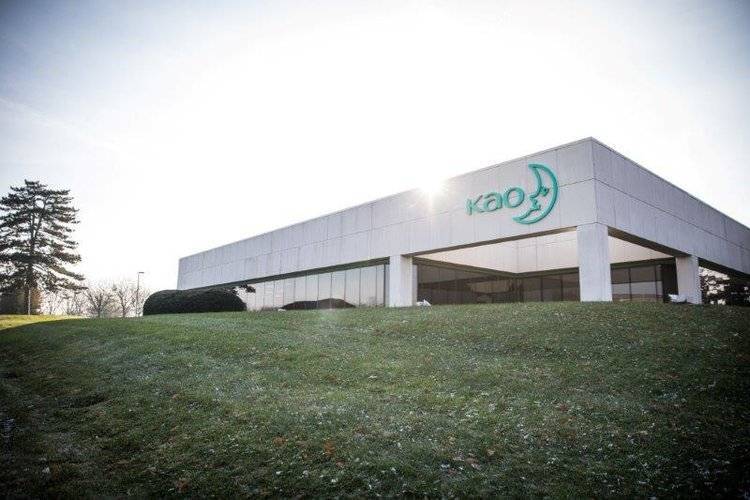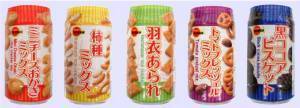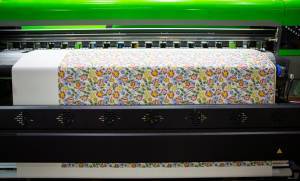
This interview previously appeared on Industrial Print Blog.
I recently heard Lawrence Gamblin from Kao Collins present at the IMI Inkjet Technology Showcase in Chicago. And the session was both inspiring and interesting. So much so, I organized a time to speak to him about his particular journey in the inkjet world. The timing of the presentation and the subsequent discussion was shortly after the announcement of Kao Corporation‘s acquisition of Collins Inkjet. So it was a good time to discuss the achievement of Kao Collins and his view on trends in the market and his opinion on the future.

Lawrence Gamblin
How did you get into making inkjet inks?
In 1982 I started making inkjet inks. My father was an inventor and scientist involved in the development of inkjet in the early days. He came up with the base solution of an ink that would compete with Kodak. I was 23 years old and didn’t know anything about business so thought I should learn something about the ink. I found that his base formula allowed for much better ink compared with other inks on the market. With my father being the inventor, this gave me a clear solution and I learned that customers actually cared about how the ink worked on the paper and how it worked in the printer. So I had to learn how to do this and formulate inks.
Trying to help develop these new market niches is like trying to hit a baseball. The probability you will hit it out of the park with anyone swing is very low. But you have to take the swing to have any chance of success, Lawrence Gamblin
A lot of my success formulating inks came from endless hours observing how the inks performed in a production environment and listening to the observations of the printer operators. Over time I realized a lot of formulation has as much, and sometimes more, to do with logic than chemistry. I ran this ink business for 5 years and then sold the business and went onto grad school as I wanted to learn more about business. At that point, I figured I was done with inkjet and went back to get graduate degrees in business and engineering in preparation for the rest of my professional career.
After graduate school finished I went back into the ink business. I borrowed $10K from my wife and rented a garage under the Manhattan Bridge in Brooklyn which was infested with rats!! There I was, with two masters degrees in a very unpleasant working environment which was 40 degrees in the winter, wondering what the hell I was doing!
So why did you decide to relaunch an ink business after grad school?
The company we initially sold to, did something really underhanded. And this really fuelled me to get back into the ink business. I thought at the beginning it would only grow into $600K or $700K business. I took on two other jobs (one strategy with a professor) and other things on the side to bring money in, and slowly things started to develop and we did a little better than my original predictions!
Why have you remained focused on inkjet inks?
Historically the inkjet industry could be characterized as a series of niche markets. At least in my experience, the growth in inkjet comes from developing new niche market applications. Some will remain relatively obscure while others will grow into significant market segments. Good examples of this include transactional document and textile printing, both of which really didn’t exist 10 years ago. Trying to help develop these new market niches is like trying to hit a baseball. The probability you will hit it out of the park with anyone swing is very low. But you have to take the swing to have any chance of success. You have to take the approach. Inviting customers to send us problems then trying to solve them has created a really interesting business and it has worked out for us. An additional benefit of our approach is that the more inks you develop the better you become at ink development.
Eventually our approach by aggressively pushing the envelope and spending a lot of time learning from, and listening to customers allowed us to take half the market for Kodak Versamark inks. Kodak eventually asked if us if we should work together which we did until they declared bankruptcy. Shortly before we started working with Kodak, HP came out with a business selling older inkjet cartridges and hardware to developers of inkjet printers. The first printers represented a threat to one part of the Kodak Versamark business. I initially approached HP and said we knew the customers and understood their requirements. HP told us they didn’t think we had anything to offer. It was one of the best things HP could have done for us. We entered the business using remanufactured inkjet cartridges and within two years, we achieved 30-40% of the business whereupon HP asked whether it made sense for us to work together. Had HP taken me up on my initial offer, I doubt we would have been anywhere nearly as successful as we have been.
So you have challenged some big companies. What do you think has been the key to this success?
I think that solving problems has been central to our success. By solving problems this means you do something different and are unique. I’ve tried to avoid the herd mentality and, except where we have something unique to offer, tended to avoid pursuing markets that everyone else is focussed on. You have to be able to do something the other guy can’t, and create new opportunities for your customers to widen the spectrum of what is possible. Customers tend to be much more open to pursuing new markets with their existing equipment because if often means they can charge a premium for their inkjet printed output. Much of our success and the success of our customers comes from close cooperation as we identify opportunities and then learn how to create novel solutions so that our customers can capitalize on those opportunities. In general the more freedom we’ve had the better it has been for our customers, equipment suppliers, and us.
What applications was the ink originally made for?
In our early days, the applications for our inks were for publishers, sweepstakes, lottery tickets, and the printing of addresses onto envelopes and catalogs. It was a market nobody cared about and we could quietly grow and prosper.
Our original inks for HP cartridges were formulated to meet the needs of the mailing and addressing market. Now, over 15 years later, HP cartridges are used for a wide range of applications including package coding on both porous and non-porous substrates and for a range of niche applications where an easy to use, robust, low-cost solution allows customers to print variable data.
Read More: The Science of Security Ink
Why not sell out years ago?
Yes it was possible, to be honest, 14 or 15 companies made an approach us before Kao did. But for me, any potential buyer would have to bring something to the table so I was very selective. I like to think I know inkjet and that I am not ready to stop innovating just because I have sold the business. The fact is that we have been supplying big high-speed printers such as RR Donnelly for over 25 years. I’ve watched as new companies came into the market with these web presses.
While they have certainly been successful it doesn’t seem as though they truly understand what is needed in order to support the needs of high-speed large volume customers, and let’s face it, that is one of the long term goals of inkjet. For a lot of our customers, press downtime costs them over $2500 per hour. Those presses run 24 hours a day, 7 days a week. You have to do whatever you can to get those printers running as quickly as possible and help them create new markets for their printed output. Our ability to support our customers and anticipate their needs has been a huge part of our success.
So tell us more about industrial UV and Electron Beam inks?
Our inks tend to be used for single pass printing for commercial print and industrial printing. We expanded our inkjet range so we can meet that demand for industrial inkjet with UV and electron beam inks. The single pass UV inkjet ink market is still small but growing rapidly. Electron Beam inkjet technology appears to be poised to become a major player in the development of high-speed energy curable inkjet markets, especially for food packaging and other applications where the safety of the printed output is of paramount importance. For us, expanding into energy curable inks was the next logical step as our customers were already using our inks for their water and solvent based applications, and were in need of energy curable solutions.
What was the biggest challenge for you building the business?
The primary thing is the comfort factor as you are asking customers to take a risk with you. Customers are very nervous about potentially damaging their expensive inkjet equipment. Overcoming that fear can be challenging. This is the primary hurdle you have to overcome. Then you need to understand what each customer wants from their inkjet printers. Some customers only want to do one thing and prize reliability over everything else. In that case, our job is to make sure they never have problems with our inks. Other customers want to gain an edge over their competitors. In that case, you provide them with marketable solutions and be prepared to nurture their new business over time as you help them achieve something new. New applications develop slowly but you end up, over time, finding customers who see the benefit of doing something that someone else can’t do.
The primary thing is the comfort factor as you are asking customers to take a risk with you, Lawrence Gamblin
Large OEMs tend to be reluctant, (although that seems to be slowly changing) to give customers the freedom to develop new solutions. This is another major challenge not only to us but to the development of the inkjet industry. We need to convince OEMs that our inks won’t damage their printers and we are not here to take their business. Our objective is to help their customers be more competitive which will ultimately lead to the sale of more printers and consumables. Often times we end up creating agreements with OEMs where we pay them royalties on any inks that go into their printers in an effort to align the interests of all parties.
What is the next challenge for ink production?
There are many challenges for inkjet and they vary by industry and application. That being said, at least on the water-based side, the continuing development of polymerically dispersed pigmented inks are changing the market. One of the major challenges in traditional printing is creating high gloss, high-density inks that resist rub off. We are getting closer and closer to being able to achieve that. Other polymerically dispersed pigmented inks allow us to print water-based inks on films and it appears others may be the key to the growth of inkjet in textile printing.

Read More: The Next Big Thing in Inkjet | Printing Water-Based LUNAJET Ink on Flexible Film
Looking towards the future the challenge will be to continue on with the work that has already been done. Pigment dispersion companies need to expand the polymeric functionality of their dispersions in order to be able to print on papers, films, textiles and other materials. The cost of producing pigment dispersions will also have to come down in order for inkjet to become a more viable alternative to traditional printing.
Do new customers tend to think ink is priced too high?
In my experience, the price for inkjet inks is set artificially high as a way for the OEM to ensure their business is profitable. I expect that model will slowly succumb to market forces. I’ve spoken with countless printers and a number of printer OEMs about the cost of inkjet inks. I hypothesize that if the price for inkjet inks are significantly lower that everyone will be more profitable. Every printer I have talked to thinks it is obvious. The lower their cost the more they print. Printers look at the tradeoff between printing something using traditional presses and printing the same thing using inkjet. In their eyes, a reduction in the price of ink by 50 or 75 percent would lead to an exponential growth in inkjet printing.
I saw a graph produced by Infotrends. According to the graph if inks cost $150 per liter the trade-off between offset and inkjet is between 4,000 to 10,000 documents. If the cost is $25 per liter the trade-off is something like 1,000,000 to 2,000,000. As an ink marker, I can assure you I will make a lot more money selling 100 times more ink at a lower margin than I would the smaller amount at the higher margin.
In your opinion is personalization a key driver?
There is a move to personalized products with high profile examples such as the Coke campaign. And this needs to happen as until someone like Coke comes in and sees the value of it then people are reluctant to take that first step. This is often a problem with a new market but it will get there eventually.
Read More: Digital Printing is Helping Personalize Packaging
What is the barrier?
Right now there is a shortage of desire. I think demand is there but desire is not. There are a lot of people who want to integrate inkjet into their existing production lines and there are not many alternative systems that are designed for that kind of installation. I don’t think there are enough integrators, but that has been changing. We are finding that we are formulating ink for specific applications. Putting those pieces together isn’t impossible, so it’s more a question of ‘when’? as opposed to ‘if.’? There is room for more but getting this technology into play isn’t easy especially if the integrator is missing from the process. This will need to change in order to accelerate adoption.
Do you think industrial inkjet printing customers expect high-speed production?
That is a difficult question. For printers, everything revolves around the total cost to print. For some applications, unless inkjet gets faster it won’t gain a lot of traction because they want to incorporate inkjet into their existing production. For others, a slower speed is ok as long as the total cost to print is competitive with what they are doing now.
Read More: 4 Markets Benefiting from Advances in Industrial Inkjet Printing
As I said the total cost to print is of paramount importance to a printer. They want to know – how much the printing device costs? What do the consumables cost? How fast does it go? How reliable is it? What happens when it breaks down? and if it does break down,how long will it take to have it back up and running at production speeds? In my opinion, these are the questions the industry needs to address.
Many existing customers cannot have a back-up supplier. They have one technology provider. For most manufacturing operations, having a sole supplier cuts against the grain of everything you are taught. You always try to have a number of potential suppliers so one can step in just in case something goes wrong.
So in your opinion is integrating difficult?
It is challenging yes, but there are some very good integrators out there. On the positive side, it is much easier to build a printer now. 20 years ago you had to have electrical engineers, engineers, programmers, etc etc. Nowadays you can buy print engines, drive electronics, fluid sub-assemblies among other things which allow the integrator to customize to suit any production environment. We are going to have our first printhead soon and an engine that deals with 80% of the production, then the integrator will customize accordingly. And we work with worldwide integrators.
Is it sometimes difficult to produce a new ink if the market is yet to be proven?
As I said earlier sometimes you need to take the swing. But we take on projects if it helps to make us smarter. We get to see what the market wants and a good way to keep relationships. If the project fails you maintain the relationship going forward as you are in it together, as partners.
What is your opinion of the future and what is required for the market to develop?
At least from my perspective, it’s more a question of when the inkjet market develops. There will always be a need for the continued development of printheads, inks, drying/curing solutions, and media. Other than that there will be a need to make inkjet solutions that can be installed inline with existing production machinery.
I believe that in order for inkjet to become a viable alternative to high-speed traditional printing, the market will eventually have to adopt business models that mimic what you see in traditional printing markets. The traditional printing market developed over hundreds of years. It works. Traditional printing is an open market where the supplier’s profits are tied to the value they bring to the market.
I see signs that the inkjet market will become a significant alternative to other forms of printing. A number of the large OEMs seem to be loosening the control they once insisted they have over their customers. The convergence of printhead, ink, drying/curing, and media development is making possible what was once unthinkable. I can’t tell you how many things are being done now which I never thought would be possible.
Kao Collins produces inkjet inks for these printheads: Dimatix, Funai, HP, Kodak, Konica Minolta, Kyocera, Ricoh, SII Printek, and Xaar.






